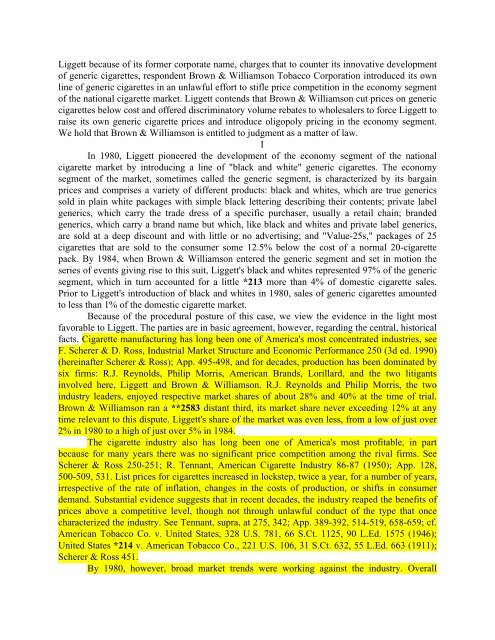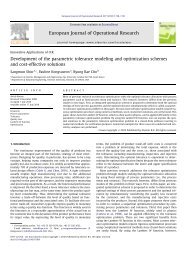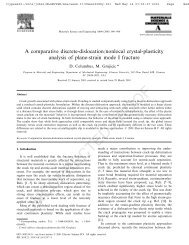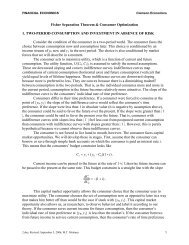509 U.S. 209, 113 S.Ct. 2578 BROOKE GROUP LTD., Petitioner v ...
509 U.S. 209, 113 S.Ct. 2578 BROOKE GROUP LTD., Petitioner v ...
509 U.S. 209, 113 S.Ct. 2578 BROOKE GROUP LTD., Petitioner v ...
You also want an ePaper? Increase the reach of your titles
YUMPU automatically turns print PDFs into web optimized ePapers that Google loves.
Liggett because of its former corporate name, charges that to counter its innovative development<br />
of generic cigarettes, respondent Brown & Williamson Tobacco Corporation introduced its own<br />
line of generic cigarettes in an unlawful effort to stifle price competition in the economy segment<br />
of the national cigarette market. Liggett contends that Brown & Williamson cut prices on generic<br />
cigarettes below cost and offered discriminatory volume rebates to wholesalers to force Liggett to<br />
raise its own generic cigarette prices and introduce oligopoly pricing in the economy segment.<br />
We hold that Brown & Williamson is entitled to judgment as a matter of law.<br />
I<br />
In 1980, Liggett pioneered the development of the economy segment of the national<br />
cigarette market by introducing a line of "black and white" generic cigarettes. The economy<br />
segment of the market, sometimes called the generic segment, is characterized by its bargain<br />
prices and comprises a variety of different products: black and whites, which are true generics<br />
sold in plain white packages with simple black lettering describing their contents; private label<br />
generics, which carry the trade dress of a specific purchaser, usually a retail chain; branded<br />
generics, which carry a brand name but which, like black and whites and private label generics,<br />
are sold at a deep discount and with little or no advertising; and "Value-25s," packages of 25<br />
cigarettes that are sold to the consumer some 12.5% below the cost of a normal 20-cigarette<br />
pack. By 1984, when Brown & Williamson entered the generic segment and set in motion the<br />
series of events giving rise to this suit, Liggett's black and whites represented 97% of the generic<br />
segment, which in turn accounted for a little *213 more than 4% of domestic cigarette sales.<br />
Prior to Liggett's introduction of black and whites in 1980, sales of generic cigarettes amounted<br />
to less than 1% of the domestic cigarette market.<br />
Because of the procedural posture of this case, we view the evidence in the light most<br />
favorable to Liggett. The parties are in basic agreement, however, regarding the central, historical<br />
facts. Cigarette manufacturing has long been one of America's most concentrated industries, see<br />
F. Scherer & D. Ross, Industrial Market Structure and Economic Performance 250 (3d ed. 1990)<br />
(hereinafter Scherer & Ross); App. 495-498, and for decades, production has been dominated by<br />
six firms: R.J. Reynolds, Philip Morris, American Brands, Lorillard, and the two litigants<br />
involved here, Liggett and Brown & Williamson. R.J. Reynolds and Philip Morris, the two<br />
industry leaders, enjoyed respective market shares of about 28% and 40% at the time of trial.<br />
Brown & Williamson ran a **2583 distant third, its market share never exceeding 12% at any<br />
time relevant to this dispute. Liggett's share of the market was even less, from a low of just over<br />
2% in 1980 to a high of just over 5% in 1984.<br />
The cigarette industry also has long been one of America's most profitable, in part<br />
because for many years there was no significant price competition among the rival firms. See<br />
Scherer & Ross 250-251; R. Tennant, American Cigarette Industry 86-87 (1950); App. 128,<br />
500-<strong>509</strong>, 531. List prices for cigarettes increased in lockstep, twice a year, for a number of years,<br />
irrespective of the rate of inflation, changes in the costs of production, or shifts in consumer<br />
demand. Substantial evidence suggests that in recent decades, the industry reaped the benefits of<br />
prices above a competitive level, though not through unlawful conduct of the type that once<br />
characterized the industry. See Tennant, supra, at 275, 342; App. 389-392, 514-519, 658-659; cf.<br />
American Tobacco Co. v. United States, 328 U.S. 781, 66 S.<strong>Ct</strong>. 1125, 90 L.Ed. 1575 (1946);<br />
United States *214 v. American Tobacco Co., 221 U.S. 106, 31 S.<strong>Ct</strong>. 632, 55 L.Ed. 663 (1911);<br />
Scherer & Ross 451.<br />
By 1980, however, broad market trends were working against the industry. Overall
















